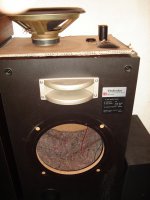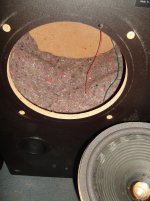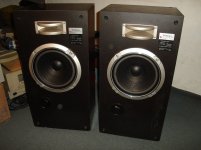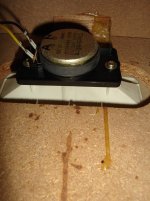A few years ago I repaired (changed the foam wings) some Technics SB-1950 cabinets.
I had never seen anything like it.... 😱
Can someone explain what is the theory behind the use of this terry cloth stapled inside?
The cloth divides the inner compartment in two, so the tuning tube is tuned for the upper or lower volume ?
Or for the total volume, because it is the same as putting a sock inside the duct, the air will pass anyway?
Opinions ? 🙂
I had never seen anything like it.... 😱
Can someone explain what is the theory behind the use of this terry cloth stapled inside?
The cloth divides the inner compartment in two, so the tuning tube is tuned for the upper or lower volume ?
Or for the total volume, because it is the same as putting a sock inside the duct, the air will pass anyway?
Opinions ? 🙂
Attachments
I actually picked up a pair of these at a garage sale here some time ago and vaguely recall that the stuffing was placed just like this.
I didn't really think much about it at the time, I imagine it's just an attempt to stop some of the midrange slipping out of the port. It's not going to stop any bass.
I didn't really think much about it at the time, I imagine it's just an attempt to stop some of the midrange slipping out of the port. It's not going to stop any bass.
Could be, but wouldn't that be counterproductive?
I still have them and one of the shortcomings is that the media is too weak, no impact. (Despite being two-way, well crossed cabinets do not suffer from this lack) I could not find the FR specs
No overlap , but that little "Mantaray" horn, it doesn't favor the mids at all.
I think it would be better to let the media emanating from the cone's back wave flow through the tuning tube freely.
I think it was a cost saving and killing some resonances with that contraption ....
One day I could try taking out the felt and covering the walls with polyfill, I think it would improve. But I think it's not worth it. I'll sell them as soon as I can.
Thanks for your answer.
I still have them and one of the shortcomings is that the media is too weak, no impact. (Despite being two-way, well crossed cabinets do not suffer from this lack) I could not find the FR specs
No overlap , but that little "Mantaray" horn, it doesn't favor the mids at all.
I think it would be better to let the media emanating from the cone's back wave flow through the tuning tube freely.
I think it was a cost saving and killing some resonances with that contraption ....
One day I could try taking out the felt and covering the walls with polyfill, I think it would improve. But I think it's not worth it. I'll sell them as soon as I can.
Thanks for your answer.
I think it would be better to let the media emanating from the cone's back wave flow through the tuning tube freely.
By all means NO !! Midrange radiation from the backside of a cone is very uncontrolled, let alone after having gone through a cab and port (pipe resonance !). So the only thing you want to let pas through the port is bass around the Tuning frequency. Your lack of midrange as to be cured in another way.
Regards
Charles
I can't comment too much as the pair I picked up were actually missing a tweeter and the woofers had been replaced (with much better quality units).
I used them as mid/bass units for FAST system. Performed well.
I used them as mid/bass units for FAST system. Performed well.
the filler is felt sheet.
normally one layer is glued/stapled to the cabinet walls before then having polyester wadding put in.
normally one layer is glued/stapled to the cabinet walls before then having polyester wadding put in.
By all means NO !! Midrange radiation from the backside of a cone is very uncontrolled, let alone after having gone through a cab and port (pipe resonance !). So the only thing you want to let pas through the port is bass around the Tuning frequency. Your lack of midrange as to be cured in another way.
Regards
Charles
No no no....
I don't know of any two-way BR cabinets, (even Horns, my Troels-designed DTQWTII is like that too ....) that doesn't appreciate the back wave, the mid-lows are present there and will also come out of the tuning tube along with the range low.
Another thing is a special compartment for a dedicated midrange speaker, where common practice is to isolate it acoustically from the internal volume with a small chamber.
A Voigt horn is the same, with a radiated midrange in front and rear of the speaker full range.
the filler is felt sheet.
normally one layer is glued/stapled to the cabinet walls before then having polyester wadding put in.
It does not clarify the question, I already know that, and here there is no internal cladding on the walls.
So I think it was made this way to eliminate some specific frequency that would resonate too much in a cabinet with walls too thin for its size and without any other absorption material.
Attachments
- Home
- Loudspeakers
- Multi-Way
- Technics SB-1950 interior filler unknown




